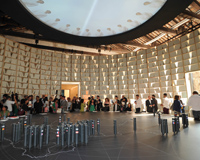Contact Center
.
07 June 2014
MOC Participates in Venice 14th International Architecture Exhibition


For its third participation, the Kingdom of Bahrain has decided to concentrate on the wider Arab World and use the opportunity of the pavilion to support the efforts of the Arab Centre for Architecture in creating a centralized archival database of architectural documents from across the Arab World. H.E Shaikha Mai bint Mohammad Al Khalifa, Minister of Culture, on last Thursday ( 5th June 2014) opened the Culture Ministry's pavilion titled (Fundamentalists and Other Arab Modernisms). Bahraini pavilion exhibits the architectural developments in the Arab region during the past 100 years and their relationship to the architectural culture of the countries had previously colonized the Arab region.
Fundamentals will be a biennale about architecture, not architects. After several biennales dedicated to the celebration of the contemporary, Fundamentals will focus on histories – on the inevitable elements of all architecture used by any architect, anywhere, anytime (the door, the floor, the ceiling etc.) and on the evolution of national architectures in the last 100 years. In three complementary manifestations – taking place in the Central Pavilion, the Arsenale, and the National Pavilions – this retrospective will generate a fresh understanding of the richness of architecture’s fundamental repertoire, apparently so exhausted today.
H.E Shaikha Mai Bint Mohammad Al-Khalifa, Minister of Culture, said during the inauguration of the Bahraini pavilion “We have a Typical experience in Manama where modernity and identity go hand in hand, our urban architecture is unique and we are proud to show the world our heritage”. H.E has argued that one hundred years later, under the influence of wars, diverse political regimes, different states of development, national and international architectural movements, individual talents, friendships, random personal trajectories and technological developments, architectures in more than 100 Arab countries that were once specific and local have become interchangeable and global. National identity has seemingly been sacrificed to modernity. The exhibition has been designed by DW5/ Bernard Khoury architects in Beirut and consists of a large-scale map of the Arab World that references both the colonial map and the real estate developer’s maps that have become ubiquitous across the Arab world. A circular library that contains the exhibition catalogue and gathers a selection of a hundred built projects between 1914 and 2014 across the Arab World surrounds the map. Above the installation, a dome supports projections of a commissioned screenplay by Hatem Imam which comprises of a reading of the 22 national anthems of the Arab countries.
In parallel to the exhibition in Venice, significant efforts have been made toward the collection of over 700 archival buildings that have been added to the database of the ACA that will be online to coincide with the opening of the Biennale. Fundamentalists and Other Arab Modernisms is an exploration of the links between colonialism, fundamentalism and modernity across the Arab World, in an effort to understand the links between each of these movements and their relation to the architecture of the time. At a time, where the Arab World is witnessing many changes, it seemed relevant to reflect on the legacy of the pan - Arab project.
A collection of seven different essays form the scientific content of the exhibition and offer a historical overview of the evolution of architecture within the different geographical components of the Arab World: Iraq, the Gulf Region, Egypt, the Levant, North Africa and East Africa. Each essay is accompanied by a selection of relevant archival documents of buildings from that region within the historical period of 1914 to 2014. The archival documents gathered in the publication represent a selection from within the wider collection of archives that were gathered for the exhibition and will be made available on the online database of the Arab Centre for Architecture.
The Ministry of Culture’s pavilion supports the efforts of the Arab Centre for Architecture in creating a centralized archival database of architectural documents from across the Arab World. First the big news of the 14th Biennale of Architecture in Venice 2014 regarding the national pavilions: with Absorbing Modernity 1914-2014 their contributions become more free and customizable than previous editions of the Biennale, when they had to submit to the general theme adopted by the curator for 'their' show. Absorbing Modernity 1914-2014 wants to invite the national pavilions to abandon the individual national characteristics to adopt a universal language and a set of uniform types: Venice, the Biennale Fundamentals opens the way to a rich, complex and stimulating comparison between different cultures techniques and inventions peculiar to each country.
This year, the national pavilions at the 14th Architecture Biennale in Venice should engage a single theme "Absorbing Modernity: 1914 - 2014" and show there national characteristics and development of the last 100 years. Absorbing Modernity: 1914-2014 is an invitation to the national pavilions to show, each in their own way, the process of the erasure of national characteristics in architecture in favor of the almost universal adoption of a single modern language and a single repertoire of typologies – a more complex process than we typically recognize, involving significant encounters between cultures, technical inventions, and hidden ways of remaining 'national. This year’s exhibition features the participation of 65 countries–including 11 first-time participants (Azerbaijan, Côte d’Ivoire, Costa Rica, Dominican Republic, United Arab Emirates, Indonesia, Kenya, Morocco, Mozambique, New Zealand and Turkey).
Worth to mention that this is the 3rd participation of the Kingdom of Bahrain after it has been awarded a Golden Lion at the 2010 Venice Biennale. Bahrain has been also awarded for the best national participation at the 12th Venice Architecture Biennale, whereby theme of the pavilion was “ RECLAIM”.







